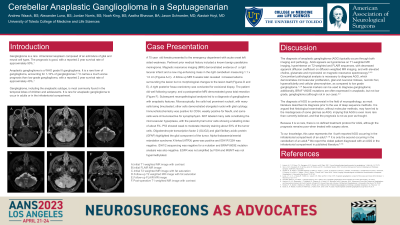Cerebellar Anaplastic Ganglioglioma in a Septuagenarian
Friday, April 21, 2023


Andrew L. Waack, BS
Medical Student
University of Toledo College of Medicine and Life Sciences
Holland, Ohio, United States
ePoster Presenter(s)
Introduction: Ganglioglioma is a rare intracranial neoplasm that predominantly affects children and adolescents. It occurs most commonly in the temporal lobe and is frequently associated with epilepsy. Anaplastic ganglioglioma is a WHO grade III ganglioglioma and represents 1-10% of all gangliogliomas. Posterior fossa anaplastic ganglioglioma in adults is extremely rare, with only one reported case in a young male. We present a case of cerebellar anaplastic ganglioglioma in a 75-year-old female. This is only the second cerebellar anaplastic ganglioglioma reported in an adult, and it is the first report in a patient over the age of 40.
Methods: Electronic charts, imaging, pathology reports and surgical reports were analyzed. Relevant background literature review was conducted.
Results: A 75-year-old female presented to the emergency room with left-sided weakness and was subsequently hospitalized. Stroke workup and brain magnetic resonance imaging (MRI) demonstrated a small right lacunar stroke and a ring-enhancing mass of the right cerebellum. At a visit 6 weeks later, the patient reported occasional posterior headaches and weakness. MRI revealed a ring-enhancing mass measuring 1.1 x 1.0 cm in the right posterior cerebellum with increased edema. Right posterior fossa craniotomy for excisional biopsy of the lesion was performed. A pathology consultant reported a ganglioglioma with anaplastic features. Immunohistochemistry was positive for CD34, weakly positive for NeuN, and some cells were immunoreactive for synaptophysin. P53 showed weak to moderate intensity staining in about 50% of the tumor cells. Oligodendrocyte transcription factor 2 (OLIG2) and glial fibrillary acidic protein (GFAP) highlighted the glial component of the tumor.
Conclusion : We present the case of anaplastic ganglioglioma located in the cerebellum of a septuagenarian. Although exceptionally rare, this report demonstrates that anaplastic ganglioglioma should be included in the differential diagnosis of posterior fossa lesions of older adults.
Methods: Electronic charts, imaging, pathology reports and surgical reports were analyzed. Relevant background literature review was conducted.
Results: A 75-year-old female presented to the emergency room with left-sided weakness and was subsequently hospitalized. Stroke workup and brain magnetic resonance imaging (MRI) demonstrated a small right lacunar stroke and a ring-enhancing mass of the right cerebellum. At a visit 6 weeks later, the patient reported occasional posterior headaches and weakness. MRI revealed a ring-enhancing mass measuring 1.1 x 1.0 cm in the right posterior cerebellum with increased edema. Right posterior fossa craniotomy for excisional biopsy of the lesion was performed. A pathology consultant reported a ganglioglioma with anaplastic features. Immunohistochemistry was positive for CD34, weakly positive for NeuN, and some cells were immunoreactive for synaptophysin. P53 showed weak to moderate intensity staining in about 50% of the tumor cells. Oligodendrocyte transcription factor 2 (OLIG2) and glial fibrillary acidic protein (GFAP) highlighted the glial component of the tumor.
Conclusion : We present the case of anaplastic ganglioglioma located in the cerebellum of a septuagenarian. Although exceptionally rare, this report demonstrates that anaplastic ganglioglioma should be included in the differential diagnosis of posterior fossa lesions of older adults.
